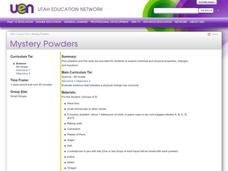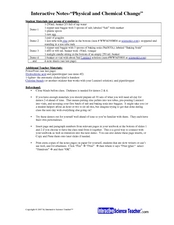Curated OER
Physical and Chemical Changes
Sixth graders complete several experiments about chemical and physical changes. In this physical and chemical science lesson, 6th graders complete 6 experiments about chemical and physical changes. Students examine the processes of...
Curated OER
Chemical and Physical Changes Lab
In this chemical and physical change worksheet, students conduct a variety of experiments with unknown solutions and make observations. Students determine if the properties of the solutions have changed and if there is a chemical or...
American Chemical Society
What is a Chemical Reaction?
When a candle burns down, what happens to the mass that appears to be shrinking? Lesson begins with a demonstration of the chemical reaction of a candle burning. Then scholars use atom models to observe conservation of mass concretely.
Curated OER
Fizzy Pop
Fifth graders compare and identify variables that affect the rate of a chemical change using Alka-Seltzer, water, ice, and hot water. They time how long each variable takes to pop the canister into the air, and record the results on a...
Curated OER
State Change
Eighth graders explore the physical change of matter. As a class, they discuss their favorite super hero and determine if the hero undergoes a physical or chemical change. Students examine the change of state and phase change. In groups,...
Curated OER
Comparing Physical and Chemical Properties
In this matter properties worksheet, students complete a Venn diagram by comparing and contrasting physical and chemical properties.
Curated OER
Physical or Chemical Change
In this matter worksheet, students read statements about changes happening to matter and classify the change as either a physical or a chemical change. This worksheet is a graphic organizer.
Curated OER
Physical/Chemical Properties of a Burning Candle
Students investigate the physical and chemical properties of a candle before and after it is lit. They conduct a burning candle experiment, and complete a KWL chart and worksheet, recording the results of the investigation.
Curated OER
A Chemical Curiosity
In this chemical change worksheet, students review physical changes such as evaporation and condensation before working with chemical change. They conduct an experiment with vinegar and baking soda before recording the chemical changes...
Virginia Department of Education
Weathering of Limestone
We all know limestone weathers, but what affects the rate of weathering? Young scientists investigate the physical and chemical weathering of limestone (chalk) through experimentation. First, they conduct trials with different-size...
Curated OER
Physical vs. Chemical Change Lab
Students recognize both a physical and chemical change in different substances. They determine which particles actually changed into different substances, and explain if it represented a physical or a chemical change.
American Chemical Society
Formation of a Precipitate
Conclude this chemical change unit by having your class combine two liquids that result in formation of a precipitate. The learners discover that chemical reactions result in new materials. Make sure to consider all of the preceding...
Curated OER
Chemical and Physical Changes Homework
In this chemical and physical change worksheet, learners determine if 5 statements are examples of chemical or physical changes. At home they find 1 example of a chemical change and 1 example of a physical change. They explain why each...
Curated OER
Kitchen Chemistry
Fifth graders examine both physical and chemical changes, and how to identify the difference between the two. They observe the changes that occur in butter when it is exposed to heat and cold, heat energy. In their notebooks, they write...
Curated OER
Physical and Chemical Changes
In this physical and chemical changes worksheet, students will read 4 different examples of a physical or chemical change and will write in the effect of each of these changes.
Curated OER
Food Packaging
Students identify the functions of packaging food and how the designs work. In this food packaging instructional activity students identify the changes that occur in different types of materials.
Curated OER
Mystery Powders
Fifth graders evaluate the physical properties of 5 powders. Each powder is subject to different conditions. They describe each observation as with a chemical change or a physical change.
Pingry School
Qualitative Analysis of Eleven Household Chemicals
Chemical and physical properties give compounds an identity. Learners use the identity of a compound to predict what it is. By performing different tests like solubility, flame, heat, and reactions, individuals attempt to identify an...
Chicago Botanic Garden
Food for Thought: Climate Change and Trophic Cascades
Learners examines the arctic food web with a short video about polar bears and an article about bears and warming temperatures. They design an arctic food web and discuss the trophic cascade that could come from climate change.
Curated OER
Physical vs. Chemical Properties
In this physical and chemical properties worksheet, students read a 2 page article, identify 10 changes as physical or chemical characteristics and decide whether 3 combination of objects are chemical or physical mixtures and explain why.
Curated OER
Follow Up Questions Lab 1-Chemical Reactions
In this chemical reactions worksheet, learners answer follow up questions to a lab where they were observing chemical changes in reactions after mixing products such as hydrochloric acid and sodium bicarbonate. They answer six questions...
Curated OER
Exploring the Physical and Chemical Properties of Polymers
Young scholars identify the physical and chemical properties and explore the differences. In physical and chemical property lesson students test polymers for the differences between the physical and chemical properties, record their...
Curated OER
Physical and Chemical Change
Students study the differences between physical and chemical changes. In this physical and chemical lesson students complete several labs to help them to see the differences between these changes.
American Chemical Society
Condensation
It's time to break the ice! If you are doing all of the lessons in the unit, children have already seen that increasing heat increases the rate of evaporation, but is the opposite true? Does decreasing temperature cause more condensation...

























